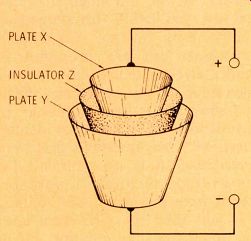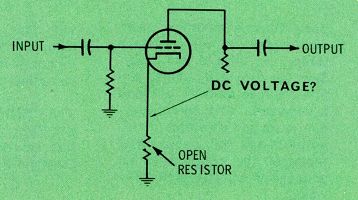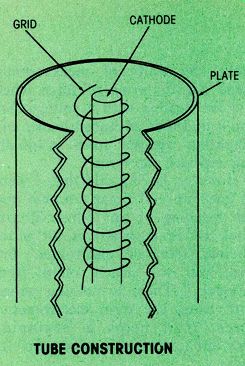
By J. A. "Sam" Wilson, CET
Letters
I have received some interesting mail about the capacitor quiz and some of the statements I made in the February Technical Notebook.
Many readers agree with me, and-as might be expected-a few disagree. So far, the letters have been professional, with clearly stated ideas. Therefore, I'm going to answer those letters that are of interest to many readers, and also to expand the theory of capacitors.
Ground rules about letters
Here are a few of my rules about letters. If I feel that my reply might embarrass a letter writer, I'll not give his name.
A time delay of two to three months is necessary before your letter can be answered in print.
Each issue of the magazine is in production for two months, and mail deliveries require several days.
I'll only print excerpts from the letters, for space will permit no more.
If these rules don't present any severe problems, then I will enjoy exchanging information with you.
Impossible Capacitor Charge?
A Texas gentleman expressed several comments in his letter, including this statement, "You are wrong!" Now, I want to dispel that idea, immediately. The only time I was wrong was the time I thought I had made a mistake! (That should keep the mailman busy.) Specifically, he was disagreeing about Question #2 about the metal pails that were nested one inside the other with a pail of dielectric between them, as shown in Figure 1. I had explained that after the capacitor is charged and the pails are disassembled, the metal pails (capacitor plates) could be touched together without discharging the capacitor. After the capacitor is assembled, the charge still remains.
This question bothered several letter writers. Perhaps I should point out that I have an advantage over the Texas reader, because I have performed this experiment probably 200 times as a demonstration to my classes. After seeing it work as described for 200 times, I believe it is true, despite the number of people who said it couldn't work that way.
However, the confusing thing about the Texas letter is that the writer and I are in violent agreement, but he seems to think we have a difference of opinion. I'll quote from the letter: "It is mis leading to think that the 'energy in a capacitor is stored in the dielectric,' as you say in the article, and as I've read in many other books at this level. The energy stored in the capacitor resides in the electric field that's between the plates." I certainly have to agree, except to point out that the electric field is in the dielectric between the plates, and that's exactly what I said.
(Incidentally, I have written a short technical monograph entitled, "Why Johnny Can't Understand Capacitors." In it, I discuss with greater detail the relationship of the dielectric and the electric field to the capacitor.)

Figure 1. Construct a capacitor with three pails, two of metal and one of
a high-voltage dielectric material. Charge the capacitor with a high DC voltage
(to compensate for the low-capacitance value). Use insulating sticks to disassemble
the pails. Short the two metal pails together (this should discharge the
capacitor, If the charge is in the air between the disassembled pails). Reassemble
the three pails, and check for a charge by using a shorting bar (with a well-insulated
handle). A large arc when the shorting bar is connected between the two metal
pails proves the charge is in the dielectric material. This drawing and the
explanation were in the October and February magazines, also.
There was one statement in his letter that's not true, however. He says, "If you remove your insulating bucket and examine it, you would find it no different from any other piece of the same material." Having done this a number of times, I can tell you quite authoritatively that the insulator is very highly charged.
And, when you handle it, the hair on your hand stands right on edge.
Excuses? One reader living in North Carolina was very glad to see the quiz, because it gave him an excuse for having failed the CET examination.
He wrote, "No wonder I have not been able to pass the ISCET test. You have done a lot of research and have ideas and knowledge the average technician never encounters." I'm sorry, but he must look else where for an excuse. First, the quiz questions in the article either were never used in the actual CET tests, or were used for a time and then withdrawn because I felt they presented unfair traps for the unwary. In the introduction of the real test, you'll find this statement:
"These tests do not have catch questions, but are intended to evaluate the tech's all-around knowledge of the electronics field. Therefore, it is not desirable to include little-known facts or slanted questions." Any questions that were determined to be too difficult for the average technician were re moved from the actual CET tests.
If you take the CET test now, you might find one question out of 75 that is related to the questions in the magazine quiz. If you miss only that one question, your grade still would be 98.6%. So, if you fail, there must be many other things that need to be learned or reviewed.
When I first started writing CET tests (about 1970), there were some complaints that the tests were too "academic." The protesters knew I was a college professor, so the complaints actually were aimed at me, rather than at the test.
After having heard thiscom plaint over and over, we gave the test to a group of college professors.
The failure rate among the professors was much higher than the technician's failure rate! That's not surprising, for the test is designed for technicians, and many questions can be answered from their practical experience without a knowledge of theory.
While I'm discussing the CET test, I'd like to say that the purpose of the whole CET program is to give technicians feelings of pride in their ability. When you pass the test, you're saying to the world, "I'm proud to be a technician, and proud of my electronic knowledge." However, I'm opposed to technicians using the CET test or rating as a form of snobbery against fellow technicians. Many top-level techs in this country are not CETs.
That does not reflect on their ability or knowledge. It means simply that they have not yet decided to take the test. Even so, I believe they should try the test, both to upgrade our industry in the eyes of outsiders, and to increase their pride of being a technician.
For Future Reference
Ddlitz Servis of Ellabell, Georgia, sent an interesting and informative letter about the relationship between the capacitance of a variable capacitor and the spacing between the rotor and stator plates.
Thanks, Mr. Servis, I'll use the information in a future article.

Figure 2 In the Technical Notebook for February, the question was asked: "What
approximate voltage should you expect to measure (with a VTVM) from cathode
to ground?" Study the next two figures, think about the theory, and
simulate the problem. More information will be given, perhaps next month.

Figure 3 Internal capacitances exist between the elements of tubes. Can
these capacitances function as uncharged capacitors, when the cathode circuit
is open?

Figure 4 Can the grid-to-plate capacitances act as an uncharged capacitor,
providing DC voltage from cathode to ground? If so, how long does the voltage
remain at the cathode?
CET Options
In a letter from Mason, Michigan, J. Ramey asked for a list o options available in the CET pro gram. At the present time, there are Consumer Electronics (radio and TV); Industrial Electronics; Communications; MATV; Audio; and Medical Electronics. I sent Mr. Ramey a list of the "CET Practice Tests" available in my monograph program.
Information also was sent to Frank Quackenbush of Canajoharie, New York.
No B + Voltage? An interesting letter came from Barry C. Duncan of Rampoul, Illinois. It concerned Question #8, which is repeated here.
Question #8
In the tube circuit of Figure 2, the plate current of the amplifier tube has been cut off because of the open cathode-bias resistor.
What approximate voltage should you expect to measure with a VTVM from cathode to ground? Duncan and his boss tried an experiment by wiring a tube with out a cathode resistor, and then measured the cathode-to-ground voltage. He measured a higher-than-normal voltage, but not so high as B+.
Mr. Duncan, I'm sorry you did not include the details of the experiment you conducted to demonstrate (or refute) the high cathode voltage.
This won't work properly with just any type of tube. For example, a tetrode or pentode should not be used, because the screen acts as a Faraday shield between the plate and the cathode. Certain tubes with closely-spaced grid wires don't work well either, because of the shielding effect. Also, a high-impedance meter (11 megohms or higher) is absolutely necessary (otherwise the circuit isn't really open).
However, the question was not meant to imply that you always will measure B+ voltage at the cathode.
The construction of a triode tube is somewhat like the drawing in Figure 3. If the capacitance is large enough (as it is with some triodes), the tube will behave in the same way as the uncharged capacitor in Figure 4, which passes voltage and current until it becomes charged.
Think about all these things. The results of some practical experiments will be given later, along with full schematics and readings.
Is the cathode voltage caused by the unchanged-capacitance effect, or does it result from the tube conduction through the test meter? Or both? In the meantime, thanks to Mr. Duncan for the letter.
"Sock Them Basics To Us"
In a nice letter signed as "Rapid Roy (WA9JA0)," R. B. Delange asked several questions. First, he wanted to know why an AC motor heats up excessively when the line voltage is low, even if the motor is not loaded to capacity.
Low line voltage decreases the field current, thus greatly reducing the counter EMF (voltage) that is generated by the rotating armature.
This counter voltage limits the current through the armature. So, when it is abnormally low, the motor current becomes excessive.
The second question was, "What system do you use to index your own technical library?" I have more than 7,000 pounds of books (determined by weighing them the last time I moved). I use the "Hunt" system. When I want to find information, I just hunt and hunt and hunt. Sorry, wish I could have given you more help.
He also requested the name of a good one-source reference book about industrial electrical systems.
Unfortunately, it's difficult to recommend just one book. Not all people are searching for the same information. I like my books laced with heavy portions of math, but this might not appeal to you. Some want theory, others want trouble shooting ideas. I doubt that it's possible for one single book to give you all you want.
I firmly believe in keeping a notebook for information that's interesting to me. In this way, I have accumulated a large amount of the data that I want. Also, I include notes listing the books which cover each subject. Perhaps you could begin a similar system.
Arturo Arauco of Chicago, Illinois, wanted me to recommend a book about integrated circuits.
Howard Sams sells a series of "Cookbooks" about both linear and digital types, and I recommend this series. However, if you want engineering data or troubleshooting suggestions, you'll have to look elsewhere.
Incidentally, when I teach integrated circuit logic at a beginners level, I always recommend How To Use Integrated Circuit Logic Elements by Jack Streeter (Howard W. Sams book number 21081).
Kudos From Chicago
James W. Warner of Chicago, Illinois, sent a complimentary letter.
He said, "Just received my issue of ES and have read and studied your `Notebook.' I have but one word for it: 'excellent.' Thank you and keep up the fine work." Warner went on to say he's 64 years old and works with audio equipment. In conclusion he said, "I don't ever expect to be a CET, because of the depth of knowledge required, but at my age I have enough to keep me busy." I think you are too modest, Mr. Warner.
Many technicians told me after they took the test that they were surprised by how easy it was. I'm sending you a complimentary copy of my "Audio CET Practice Test." If you can answer more than 50% of the questions in the practice test, I would advise you to try the real test. Thanks for the letter.
Microprocessors
Terry A. VanKaughnett of Raleigh, North Carolina, asked for a series of articles about micro processor systems. In my series about Basic Industrial Electronics, logic circuitry now is being discussed, and microprocessors will be analyzed in the near future. At the present time, I'm laying the ground work for an understanding of microcomputers.
The Industrial Electronics series in this magazine explains digital circuits based on TTL logic, and eventually will cover the 8080 and Z80 microprocessors. On the other hand, my technical Monographs approach the subject using CMOS and the 6080 microprocessor series.
Except for that basic difference, the articles and the monograph follow parallel paths. I believe that it's essential for technicians to know both systems. However, my experience has taught me that jumping back and forth between TTL and CMOS (and their respective micro processor types) tends to be confusing. So, it's better to stay with just one system long enough to learn the basics. Eventually, you should learn the other system, and become proficient with both.
Whatever Happened To Electromotive Force?
In a letter, Adolph Krauz of New Hyde Park, New York, asked me about the term EMF. I had said in my article that the term EMF is deprecated, and that "voltage" should be used instead.
Krauz said, "I teach electronics at the Industrial Arts level in public high school. And yes, I still teach that EMF is what pushes the electrons. The very latest texts published by Goodhart Wilcox, Electricity in Electronics by Gerrish/ Dugger and Electricity And Basic Electronics by Stephen R. Matt (copyright 1977), both concur with my belief. If, however, you are right and we are wrong, I want to know about it. As a teacher my information must be correct. Please supply me with references in your reply." The term electromotive force now is in disfavor, especially in the higher levels of text material.
Voltage is not a force, instead it is a unit of work. In the mathematics of electronics, it is not possible to make the units of measurement come out in terms of force when you are dealing with a voltage. So, you'll find that advanced books and magazine articles have gradually discontinued the term.
However, having said that, I want to back up and point out that you are teaching at an industrial arts level, which generally is an introductory level of electronics. For this, you will teach often from "models." There is nothing wrong with using the term electromotive force, if it helps a beginning student to understand electricity better.
Recently, I taught a beginning electricity course to a group of mechanical technicians from a local industry. I used the old, but effective, analogy of the water-and-pipe to explain how the electricity is moved by the pump called voltage.
Also, when I teach basic electric circuits, I continue to chase the electrons through the circuit. For this level, and the one you are teaching, the difficulty is motivating the students and capturing their to get them quickly to a point where they can perform some simple laboratory duties. At that time, there should be no detours into the more-advanced concepts of electronics.
I'm sure that Mr. Gerrish/Dugger (whom I know personally) and Stephen Matt were fully aware of all this when they wrote their books.
One more remark: teaching from models and analogies is an excellent technique to help beginners to understand. But all models have definite limitations. So, all you teachers and instructors, please hint to your students that later they must advance beyond models and learn more of the actual truth about electronics.
Next Month:
In the next Technical Notebook, I'll go back to basic principles of magnetism, and give suggestions for measuring magnetism. I'm dwelling on magnetic theory just now be cause I want to discuss some unique and fascinating components, whose operations are based on simple magnetic theory.
-----------
Sam Wilson's Technical Publications
In addition to writing for ELECTRONIC SERVICING and authoring books for several publishers, Sam Wilson has a program called "Continuing Education for Technicians." At the 1977 NESDA/ISCET convention, he was given a special award for this "CET" educational series.
Now the publications have been revised, and new material has been added. Here is a partial list:
CET Practice Tests
Associate Level Audio Journeyman
Industrial Journeyman
Consumer Journeyman
Communications Journeyman (all of these are Revised and sell for $3.50 each)
Continuing Education
Monographs
Logic Circuits--Theory and Practice (With troubleshooting) (Revised) $3.50
Flip Flops, Counting Circuits and Displays (With troubleshooting techniques) (New) $3.50
Microprocessors--Theory and Practice (With introduction to programming) (New) $3.50
Why Johnny Can't Understand Capacitors (free with order of two or more publications) $2.00
Send your check or money direct to Sam:
Sam Wilson
P.O. Box 3321
Warren, Ohio 44485.
------------
(adapted from: Electronic Servicing magazine, May 1978)
Next: June 1978
Also see: